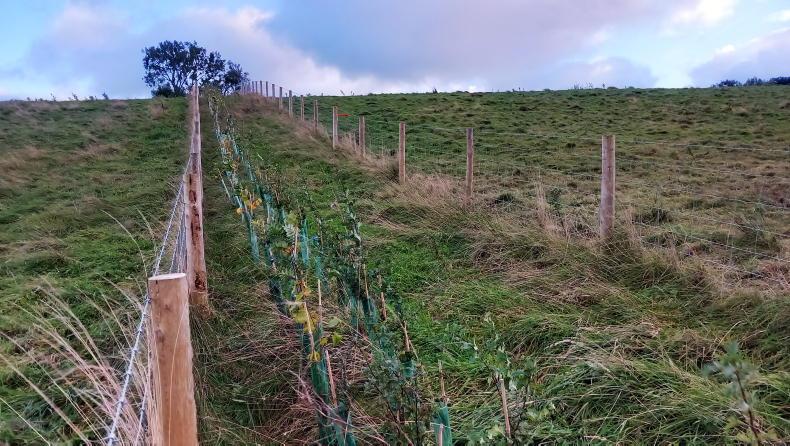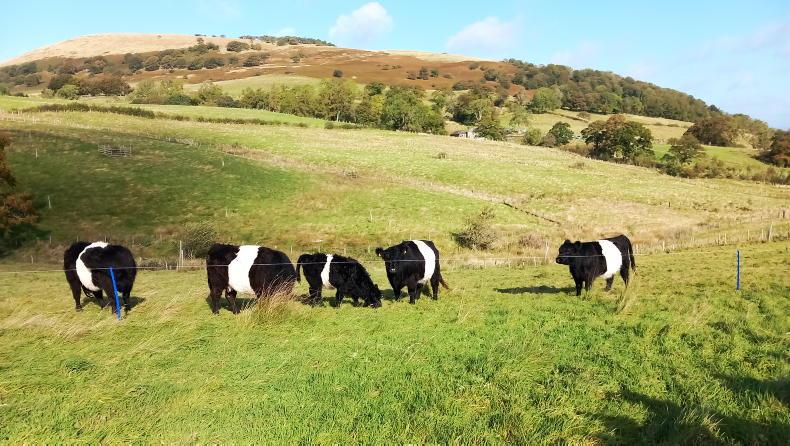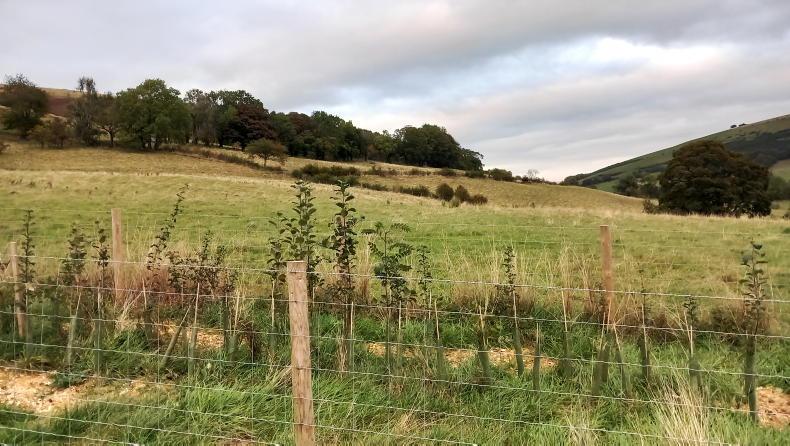It came as a surprise to me that there were very few rushes on James Rebanks’ upland farm in Cumbria, England. I had assumed the common weed would be a problem because he doesn’t use any chemical fertilisers or herbicides.
Over the past two weeks on this page, we have looked at how James manages his farm using the principles of regenerative agriculture, with a key focus on long recovery grazing (see www.ifj.ie/regen).
The Rebanks’ farm should be susceptible to rushes. It runs to 2,000ft above sea level, is in a high rainfall area and is made up of heavy, clay soils.
Indeed, neighbouring farms are clearly plagued with rushes. Just across the march ditch from James’s farm was a large field with a few sheep, little grass and lots of rushes. It’s a familiar sight in upland areas of Britain and Ireland alike.
Soil structure
The secret to James’s success is in the soil. As outlined last week, he puts a huge emphasis on managing grass to encourage deep roots, which improves the movement of air and water in the soil.
Rushes do not like soil structure like this. Instead, the weed thrives in compacted, waterlogged soils that have little airflow. “Rushes are a sign that your soils are beat,” explained regenerative grazing consultant Caroline Grindrod.
Having excellent soil structure also means there should be less trouble with other common grassland weeds, such as thistles and docks. Again, there were very few of these on the Rebanks’ farm.

Rows of trees and shrubs have been planted throughout the farm.
James rests his fields for up to 90 days after each three-day grazing event. This long recovery period allows grass plants to grow tall and establish a network of deep, dense roots in the soil.
He also only grazes half of the available grass, so the leftover cover is trampled by stock and dead material decays, which helps build soil organic matter.
Lessons
While this system of long recovery grazing will not suit everyone, I think there is an important lesson in it which can be applied to most upland farms that are prone to rush infestation.
It shows that weeds favour a short grazing rotation, where livestock graze a field often with little rest. It is even worse with a set stock system, where livestock graze the same area non-stop.
Under these systems, stock are constantly nipping off the grass plant before it gets a chance to grow. This massively hinders overall grass yields and suppresses the root of the grass plant below the ground.

Cattle are out-wintered on the Rebanks farm.
Meanwhile, livestock do not eat the rushes, thistles, and docks, so the weeds get a free pass to grow while grass is always held back.
The constant grazing and lack of a recovery period also increases the risk of poaching, which will help germinate more weeds and compact the soil structure further. It is a vicious cycle that leads to more weeds and less grass.
James points out that most upland farms used to be split into small fields, where stock were moved often. As the old saying goes, sheep should not be in the same field long enough to hear the church bells twice.
Small fields
It is only in recent decades that small fields in upland farms were merged into large parks and stock were moved less frequently. James has moved back to the old way, with his 185ac farm fenced into 55 different fields.
Asides from weed control, improved soil health on the Rebanks’ farm has huge benefits for the environment. Soil is the building block of ecosystems after all, so healthy soils can mean more biodiversity as well as less weeds.
Not everyone will want to move stock as often, have recovery periods as long, or leave post-grazing covers as high as James does.
However, there are easy wins for both farm output and nature on a lot of upland farms by simply splitting large fields, moving stock more regularly and leaving a slightly higher cover after each grazing.
Less can be more on upland farms
Cutting out fertiliser and taking a regenerative approach to farming has inevitably meant less livestock on James Rebanks’ farm.
The farm used to be home to over 500 ewes, but it now carries 300 ewes along with a small herd of 12 Belted Galloway cows.

The Lake District farm is home to 300 Herdwick ewes.
James points out that profit margins are razor thin or non-existent on many upland farms, so if cutting down livestock numbers allows input costs to fall too, is that such a bad thing? Especially if it improves overall profitability?
Although he didn’t go into detail, James maintained that his farm is making more money now than it was five years ago.

The farm is located in the Lake District in north-west England.
While he has cut back on sheep numbers, he now only keeps pedigree Herdwicks, with the aim of selling breeding rams and ewes for higher prices than ordinary commercial stock. Likewise, he is also planning to sell beef at a premium by marketing it directly to consumers. In short, he is keeping fewer stock, but they are higher value.
James writes books, so farming isn’t his only income source. That said, most upland farmers seem to rely on some level of off-farm income nowadays, regardless of their system type.
Regenerative agriculture won’t feed the growing world population, but it does offer an insight into how farming and conservation can work side by side.
It also reduces a farm’s reliance on inputs and with fertiliser prices at eye watering levels, it is something that more farmers in upland areas will probably start to dabble in.
Rushes and other common grassland weeds favour compacted soils.Improving the structure of soils helps grass out-compete weeds.Grazing livestock in smaller fields and moving them regularly with longer rests between grazings will benefit farm output and the environment.
It came as a surprise to me that there were very few rushes on James Rebanks’ upland farm in Cumbria, England. I had assumed the common weed would be a problem because he doesn’t use any chemical fertilisers or herbicides.
Over the past two weeks on this page, we have looked at how James manages his farm using the principles of regenerative agriculture, with a key focus on long recovery grazing (see www.ifj.ie/regen).
The Rebanks’ farm should be susceptible to rushes. It runs to 2,000ft above sea level, is in a high rainfall area and is made up of heavy, clay soils.
Indeed, neighbouring farms are clearly plagued with rushes. Just across the march ditch from James’s farm was a large field with a few sheep, little grass and lots of rushes. It’s a familiar sight in upland areas of Britain and Ireland alike.
Soil structure
The secret to James’s success is in the soil. As outlined last week, he puts a huge emphasis on managing grass to encourage deep roots, which improves the movement of air and water in the soil.
Rushes do not like soil structure like this. Instead, the weed thrives in compacted, waterlogged soils that have little airflow. “Rushes are a sign that your soils are beat,” explained regenerative grazing consultant Caroline Grindrod.
Having excellent soil structure also means there should be less trouble with other common grassland weeds, such as thistles and docks. Again, there were very few of these on the Rebanks’ farm.

Rows of trees and shrubs have been planted throughout the farm.
James rests his fields for up to 90 days after each three-day grazing event. This long recovery period allows grass plants to grow tall and establish a network of deep, dense roots in the soil.
He also only grazes half of the available grass, so the leftover cover is trampled by stock and dead material decays, which helps build soil organic matter.
Lessons
While this system of long recovery grazing will not suit everyone, I think there is an important lesson in it which can be applied to most upland farms that are prone to rush infestation.
It shows that weeds favour a short grazing rotation, where livestock graze a field often with little rest. It is even worse with a set stock system, where livestock graze the same area non-stop.
Under these systems, stock are constantly nipping off the grass plant before it gets a chance to grow. This massively hinders overall grass yields and suppresses the root of the grass plant below the ground.

Cattle are out-wintered on the Rebanks farm.
Meanwhile, livestock do not eat the rushes, thistles, and docks, so the weeds get a free pass to grow while grass is always held back.
The constant grazing and lack of a recovery period also increases the risk of poaching, which will help germinate more weeds and compact the soil structure further. It is a vicious cycle that leads to more weeds and less grass.
James points out that most upland farms used to be split into small fields, where stock were moved often. As the old saying goes, sheep should not be in the same field long enough to hear the church bells twice.
Small fields
It is only in recent decades that small fields in upland farms were merged into large parks and stock were moved less frequently. James has moved back to the old way, with his 185ac farm fenced into 55 different fields.
Asides from weed control, improved soil health on the Rebanks’ farm has huge benefits for the environment. Soil is the building block of ecosystems after all, so healthy soils can mean more biodiversity as well as less weeds.
Not everyone will want to move stock as often, have recovery periods as long, or leave post-grazing covers as high as James does.
However, there are easy wins for both farm output and nature on a lot of upland farms by simply splitting large fields, moving stock more regularly and leaving a slightly higher cover after each grazing.
Less can be more on upland farms
Cutting out fertiliser and taking a regenerative approach to farming has inevitably meant less livestock on James Rebanks’ farm.
The farm used to be home to over 500 ewes, but it now carries 300 ewes along with a small herd of 12 Belted Galloway cows.

The Lake District farm is home to 300 Herdwick ewes.
James points out that profit margins are razor thin or non-existent on many upland farms, so if cutting down livestock numbers allows input costs to fall too, is that such a bad thing? Especially if it improves overall profitability?
Although he didn’t go into detail, James maintained that his farm is making more money now than it was five years ago.

The farm is located in the Lake District in north-west England.
While he has cut back on sheep numbers, he now only keeps pedigree Herdwicks, with the aim of selling breeding rams and ewes for higher prices than ordinary commercial stock. Likewise, he is also planning to sell beef at a premium by marketing it directly to consumers. In short, he is keeping fewer stock, but they are higher value.
James writes books, so farming isn’t his only income source. That said, most upland farmers seem to rely on some level of off-farm income nowadays, regardless of their system type.
Regenerative agriculture won’t feed the growing world population, but it does offer an insight into how farming and conservation can work side by side.
It also reduces a farm’s reliance on inputs and with fertiliser prices at eye watering levels, it is something that more farmers in upland areas will probably start to dabble in.
Rushes and other common grassland weeds favour compacted soils.Improving the structure of soils helps grass out-compete weeds.Grazing livestock in smaller fields and moving them regularly with longer rests between grazings will benefit farm output and the environment. 










 This is a subscriber-only article
This is a subscriber-only article









SHARING OPTIONS: